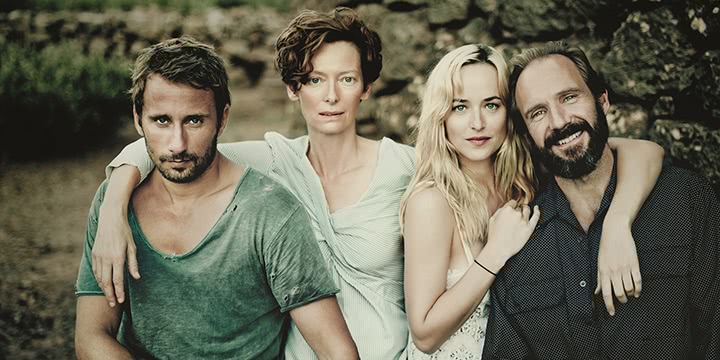In 2010, a film calledI Am Lovearrived in cinemas, and immediately stood out in an arthouse cinema landscape rife with so many films marked by a certain stylistic austerity.
Here was something that owed more to the plush, decadent style of Luchino Visconti than, say, the austere social realism of the Dardenne brothers.
After a long filmmaking hiatus, I Am Love director Luca Guadagnino has returned with the equally lush A Bigger Splash, a deceptively sunny riff on Jacques Deray’s 1969 film La Piscine. The latter film’s star wattage of Alain Delon, Romy Schneider, Maurice Ronet and Jane Birkin is here substituted for Guadagnino’s long-time collaborator (and I Am Love star) Tilda Swinton, alongside Matthias Schoenaerts, Dakota Johnson and a manic, frequently naked Ralph Fiennes, playing a holidaying quartet whose fraught dynamic eventually leads to violence.
“I tend to surround myself with the most varied, unpredictable, disconcerting mix of people,” Guadagnino says. “I’m curious, and for me it’s important to fulfil that curiosity of the other.
“I saw the movie La Piscine when I was 16, and I haven’t seen it again since,” he offers, suggesting that he came to the material with fresh eyes. “[I thought], ‘Instead of remaking it, let’s use the basic terms of the storyline as a jumping pad towards something different, or something more personal to me.’”
What’s surprising and refreshing about A Bigger Splash is how wilfully undramatic it is, before the darker turn it takes near the end. Rather, its main pleasures are experiential, which owes to Guadagnino’s expert ability to envelop you in an environment and its associated moods – in this case, the remote Italian island of Pantelleria, where rock star Marianne Lane (Swinton) and her documentarian boyfriend Paul (Schoenaerts) are enjoying a peaceful holiday, before the surprise visit of Harry (Fiennes) and his daughter Penelope (Johnson).
Guadagnino’s favouring of mood over narrative partly comes from his self-education as a filmmaker, and the autonomous development of his own practice and methodology. “I’d been working with moving images and narrative within moving images since I was a little kid, because I had my Super 8 camera when I was eight or nine, and I completely pursued my interest in that and I always made my own stuff – meaning that I never attended a film school, or … did work on other people’s sets before I did my own work.”
After his own Super 8 films, he began making documentaries, whose subjects ranged from “a blue collar Marxist theatre automobile worker” through to the Algerian Civil War in the ’90s – a vast array of subjects that puts to rest the idea that his interests lie in the activities of bored rich people.
When describing his ongoing relationship with Swinton (which started with 1999’s little-seen doco-fiction hybrid The Protagonists), Guadagnino is effusive in a way that makes you realise why the actress has yielded so many fruitful ongoing collaborations with her directors.
“Tilda is a filmmaker who has the great capacity of developing fantastic and lifelong relationships, starting with her beautiful, historical relationship with the late Derek Jarman, to the Coen brothers and Wes Anderson and so on. She’s a filmmaker … and I love filmmakers. So for me to discuss films, to think of films, to partner with a filmmaker, it’s a joy.”
Clarifying his reiteration of the term ‘filmmaker’ as opposed to ‘actor’ also emphasises Guadagnino’s unorthodox approach to screen performances. “I don’t believe Tilda is an actor – I think Tilda is a filmmaker. I never say ‘actor’ referring to her. She’s a performer and a filmmaker. She’s not looking for a ‘part’, or to play out a dramatic instance. She’s behaving – she’s looking for behaviour. There’s nothing very alluring in ‘acting’; it’s a toolbox. In the best case scenario, an actor who can act in front a camera is going to try and mimic some sort of truthfulness of life and reality. In the worst case, they will give you a sort of heightened version of what they believe is a common ground of what an attitude is, and that’s drama, which is horrible. I think behaviour is more interesting to look at than acting.”
I’m instantly reminded of Jean-Luc Godard’s insistence that “every film is a documentary of its actors”, though Guadagnino is equally combative toward that idea. When I bring up a show-stopping dance scene in A Bigger Splash, which sees Fiennes boogie to The Rolling Stones’ ‘Emotional Rescue’ in a long, unbroken take, Guadagnino replies: “I hope that when you see that scene, you see Harry, and you don’t see Ralph Fiennes having fun.”
Indeed, music plays a large role in A Bigger Splash. Alongside a handful of Rolling Stones songs are tracks from Popol Vuh, Captain Beefheart, St. Vincent, and Harry Nilsson’s ‘Jump Into The Fire’, used twice in two vastly different dramatic contexts.
“The movie had to be very rock’n’roll, and that was a great piece of rock’n’roll, and a great soundtrack for Harry,” says the director. “Harry’s endlessly listening to music, and making people listen to his music. The first time you hear ‘Jump Into The Fire’ it happens to be where they are, lounging, and then the music spurts out of the water, like in the head of Marianne.”
As with Guadagnino’s method of filmmaking as a whole, his use of music comes down to the mysteries of intuition. “It’s a process that leads me to things by reasoning with my editor, that I’m not sure I can literally describe.”
A Bigger Splash (dir. Luca Guadagnino) is in cinemas Thursday March 24.

































